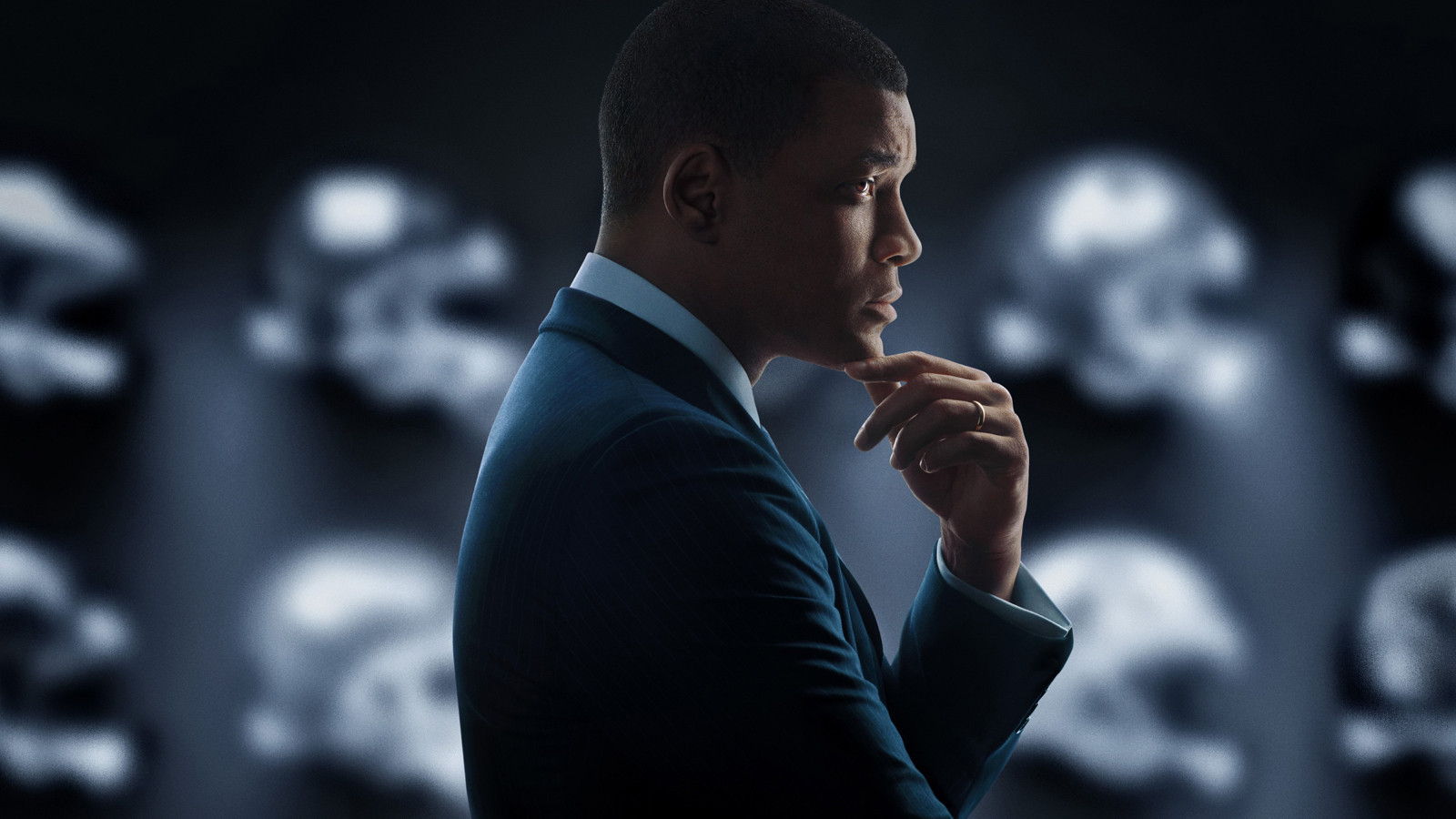Let Me Explain Exactly How the Movie Concussion Failed
[amazon template=iframe image&asin=B019T8Q426]Maybe I should start over, and I haven’t really even started yet. The movie Concussion is ok. If you didn’t know anything about the concussion controversy in the NFL it would be eye opening and fairly revelatory. And so, from that vantage, having zero understanding of the science, or the controversy or the personalities involved… I’d probably give it a 7? Maybe a 7.5 if I was feeling generous. But I’ll get to the movie in a minute. You’ve got to have a little context first.
But there is so much more to this story. This story is so much better than Will Smith and his funny accent. There is so much more science. And there is so much discovery in this story. But the writers and directors and Hollywood assumed you were too stupid to understand it. They figured that every ten seconds spent on science 10 percent of the audience would fall asleep.
Alright. Let’s really begin at the beginning again.
This whole story starts with the amazing 2009 GQ article entitled Game Brain by Jeanne Marie Laskas. The only thing that supersedes this article in GQ would be Dr. Bennet Omalu’s original paper written on the topic. But it was the GQ article that initially blew my mind as to what was going on. Here’s the amazing hook to how that article began:
“Let’s say you run a multibillion-dollar football league. And let’s say the scientific community—starting with one young pathologist in Pittsburgh and growing into a chorus of neuroscientists across the country—comes to you and says concussions are making your players crazy, crazy enough to kill themselves, and here, in these slices of brain tissue, is the proof. Do you join these scientists and try to solve the problem, or do you use your power to discredit them?”

After finding that initial article I went looking for books on the topic. League of Denial dove straight into the teeth of the controversy and opened with this salvo aimed straight at the ignorance of the NFL, our most beloved sporting colossal:
“PROFESSIONAL FOOTBALL PLAYERS DO NOT SUSTAIN FREQUENT REPETITIVE BLOWS TO THE BRAIN ON A REGULAR BASIS.” So concluded the National Football League in a December 2005 scientific paper on concussions in America’s most popular sport. That judgment, implausible even to a casual fan, also contradicted the opinion of a growing cadre of neuroscientists who worked in vain to convince the NFL that it was facing a deadly new scourge: A chronic brain disease that was driving an alarming number of players — including some of the all-time greats — to madness.
And there obviously was the story that started it all in GQ – that Jeanne Marie Laskas parlayed into a full length book. Her book was even more eye-opening in the shear scale and the vastness of the problem. Not only was it an issue for the NFL, but also for College and even high school students. This was becoming a pandemic. Which brings me to the book, The Scandal, which is all about college football and the behind the scenes chaos that has embroiled this billion dollar “scholastic” obsession.
All of which just reminded me that man’s capacity to abuse another in the pursuit of money is unbounded.
It was through this reading that I understood that players were being manipulated and abused. It was through the initial GQ stories that I began to realize that the NFL wasn’t working in the best interests of it’s players or their families. So when I heard that Ridley Scott was going to be adapting Brain Game into a feature film I was stoked. Finally the court of public opinion would jump on board and demand significant change. And then I saw it.
So How Is It I Ended Up With A Concussion?
The basic storyline of the movie is simple enough… In 2002, former Pittsburgh Steelers center Mike Webster was found dead in his pickup truck. Bennet Omalu, a forensic pathologist with the Allegheny County, Pennsylvania coroner’s office, handles Webster’s autopsy. Dr. Bennet Omalu heard the stories of Webster’s madness… his pulling out his teeth and then supergluing them back in. Here’s how Game Brain described Webster’s condition: “What had happened to him? How does a guy go from four Super Bowl rings to…pissing in his own oven and squirting Super Glue on his rotting teeth? Mike Webster bought himself a Taser gun, used that on himself to treat his back pain, would zap himself into unconsciousness just to get some sleep.” And knowing that, Omalu began digging, literally, deeper and deeper into Webster’s mind to find a reason for his madness.
Will Smith plays the deeply accented native Nigerian and he does a passable job at it. It wasn’t Will Smith that carried the biggest grief of the movie for me. But he sure didn’t help matters.
It could be that the full length movie format requires significant conflict in order to drive momentum. But Scott and writer Peter Landesman (accompanied by my crush, Jeanne Marie Laskas) just couldn’t make a significant enough conflict when there wasn’t one. A movie about a guy that says to his neighbor, you took my newspaper, and the neighbor constantly responding with, “What paper?” does not a conflict make. Yes, the NFL was about as culpable in this coverup as the cigarette manufacturing companies of the 90’s and oughts. But does that means it’ll be a convincing cinematic experience? No. Definitely not.
The most enjoyable aspects of the movie was watching Omalu hunt down this thing that no one was understanding at the time. Most of this section was the audience watching Will Smith stare pensively off into the distance and alternately staring into a microscope of the brain tissue samples he had prepared with his own money. But most of this experience we have had in the Brain Game, or in the various books that are available to talk about the science and the truly amazing discoveries, were lost in this movie. Because of the movie’s avoidance to talk about the science, we sort of just take it on faith that Omalu discovered anything at all. Occasionally other experts are brought in to consult and listen. But generally our man Omalu may or may not have really found something here. Which basically undermines the entire raison d’etre of the entire film.
Concussion Movie Explained Conclussion
The latest article in the salvo by GQ against football called for action and called for reform – which is way more than the movie. The movie basically chose to go for a lay up, a non-confrontational peace agreement, rather than a call to war. Here’s how Jeanne Marie Laskas’ latest story on the topic opened:
“When Jeanne Marie Laskas started reporting on the devastating impact of repeated hits to football players’ brains in 2009, the NFL was still in denial. By now the evidence is irrefutable, and every bloody Sunday (and Monday and Thursday) it becomes a little harder not to cringe with each collision. But if you’re a guy like former star linebacker Fred McNeill who’s living with the effects of those hits, the question is: How can we keep watching the game—and how can we keep asking our kids to play it?”
And that is where Concussion, the movie, really failed. Instead of using his final success to call for significant and wide reaching reform Omalu used it to tell stories about the wonder and glory of the sport as seen through the eyes of his wife. He personally didn’t enjoy it much, but he knew others did. And so we should all hold hands, and sing campfire songs together in unity and oneness. But that left me cold. The NFL had only just been forced to listen to facts and do something… and instead Omalu chose to compliment the game that so many loved?
No no no. Just feels weak and hollow at this point. Real reform is what needed to be called for at the end of the movie. Real change. But it felt as though the movie collapsed under it’s own weight, unsure of where to go next. And maybe that is just the reality of the day. Having just gotten the NFL to listen, what are we to do now? We can’t exactly end the game, right? Which basically means to me, that if they didn’t have a firm ending in mind, a clear call to action… why bother?
And here is where the real travesty happened. Recently though, it became apparent, that Sony has deliberately neutered the film in hopes of not getting into trouble with the NFL. The New York Times has reported that after the November 24th cyber attack they saw emails between executives at Sony that they decided to tone the movie down in order to avoid protests from the National Football League. Which actually, now that I think about it, explains everything I saw in the movie. The key email was an August 2014 email from Dwight Caines, the head of U.S. Marketing at Sony. He sent the movie out to top studio executives stating, “we’ll develop messaging with the help of NFL consultant to ensure that we are telling a dramatic story and not kicking the hornet’s nest.” And it also explains why the NFL is allowing all NFL players to see the movie free of charge. Concussion is a puff piece… that’s why.
Which is what I’m wondering about the movie in general. Having really learned so much from so many great writers and scientists, via their books and articles, I would have thought the movie would have been engaging and insightful as well. But instead it was a fairly uninspired movie that really had little to no purpose. Too bad… because it really was a cutting edge, and insightful story with a real purpose here. If only Sony hadn’t sold out.


